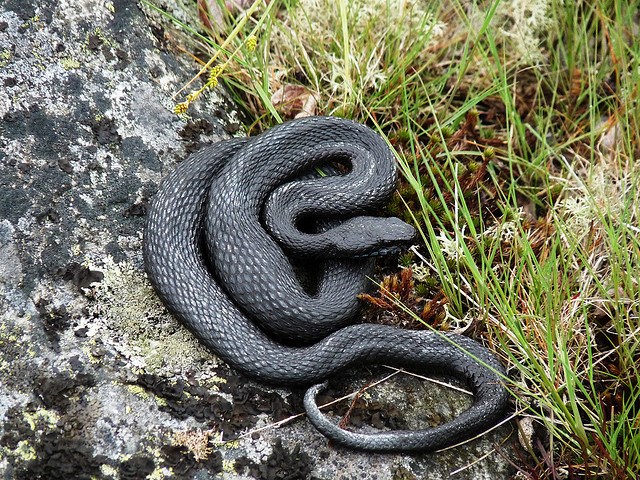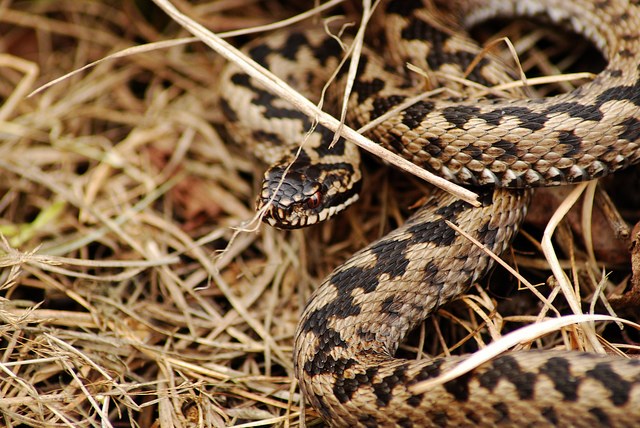You are looking for a 3L cliplock container in camoflage covering. At the outset it contained several swappable items as well as the expected logbook and stamp with ink block. I included both pencil and pen, but I do not guarantee they will last! There is also a prize for FTF...
Many thanks to the National Trust for allowing the placement of this cache. GEOCACHING ON NATIONAL TRUST PROPERTY IS AT YOUR OWN RISK

The adder is the only venomous snake native to Britain. Most adders are distinctively marked with a dark zigzag running down the length of the spine and an inverted 'V' shape on the neck. Males are generally white or pale grey with a black zigzag. Females are a pale brown colour, with a darker brown zigzag. But some adders are entirely black and can be mistaken for some other species. This is indeed the mistake we made when my five-year old nephew, Jude, spotted a black snake while we were walking to the nearby cache "Fairies, Flints and Forts". It looked like an adder in every other respect but fearful that this was an alien species released from captivity we later made enquiries. No lesser source than Stephen Backshall, the naturalist and TV presenter, informed us that black adders are rare but in fact are the most commonly reported snake sightings in Britain, and that was undoubtedly what we had seen. I should add that I do not think it highly likely you will come across adders while hunting the cache, I have visited the area more times than I can count and this is the only occasion we have spotted one - even then, four of us missed it!
Although adders have the most highly developed venom injecting mechanism of all snakes, their venom has low toxicity. A bite should still be treated as potentially life-threatening and professional advice sought as soon as possible.
If bitten:
- HEALTHY ADULT - seek urgent medical advice
- ADULT who has heart problems or is known to suffer extreme allergic reactions - this is a medical emergency
- CHILD - this is a medical emergency
- DOG - this is an extreme veterinary emergency
With proper treatment, the worst effects are usually nausea and drowsiness, followed by severe swelling and bruising in the area of the bite. The last person to die from a snake bite in Britain was a five-year old in 1975. However, adders are not aggressive animals and will only use their venom as a last means of defence, usually if caught or trodden on. Most people who are bitten were handling the snake or attempting to catch it. Treat adders with respect and leave them alone.
Adders are relatively common in areas of rough, open countryside and are often associated with woodland edge habitats. They are less inclined to disappear into the surrounding undergrowth when disturbed and so are probably the most frequently seen of the three British snakes. The 'dance of the adders' was thought to be a mating display, but it is a larger male attempting to drive off a smaller one. The snakes writhe around each other in an impressive way, often covering the ground at great speed. Unlike most reptiles, adders do not lay eggs. Young snakes are born about the size and shape of an earthworm, but a perfect miniature of the adult snake. This may have the source of the folklore about female adders swallowing their young to protect them from danger; a gravid adult cut open may have revealed an apparently young snake. In reality, if a mother did swallow her young, it would kill them!
Adders usually eat small rodents, such as voles, but they will also eat lizards, frogs, newts, and the young from nests of ground nesting birds. When hunting, adders strike swiftly at the prey, injecting a lethal dose of venom. They then wait until the prey dies before starting the often lengthy swallowing process. Like all snakes, adders eat their prey whole, their teeth are designed to grip the prey as it is swallowed. Their jaws are linked by extensible connective tissue so each of the four main bones can move independently. This means they are able to swallow items much larger than the width of their head. The lower ends of the ribs are not joined as in most animals and can also open out considerably. The adder's digestive fluid is amazingly powerful and will digest the flesh and bones of their prey almost completely. Only the hair and teeth of rodents pass through intact.
Young adders are threatened by a variety of predators, including birds of prey such as the common buzzard and sometimes adult snakes. Others may be killed and eaten by rodents while in hibernation. Adders are protected by law against being killed or injured through human activity.
The adder makes various appearances in english literature and folklore. Thomas Hardy wrote of using the fried fat of the snake to cure a bite from the same (this does not work!) in "The Return of the Native". An adder supposedly appeared when King Arthur and Mordred's armies faced each other; the raising of a sword to kill it by one of the King's men was taken as aggression by Mordred's side and thus the snake began the battle in which King Arthur died. Shakespeare makes a number of references to adders, including the famous quote from Macbeth: "Eye of newt and toe of frog. Wool of bat and tongue of dog, Adder’s fork and blind-worm’s sting, Lizards leg and owlets wing." More recently the animal lent it's name to Rowan Atkinson's titular character in the popular series of TV and radio comedies produced since 1982 and set throughout various times in English history between 15th and 21st centuries.
